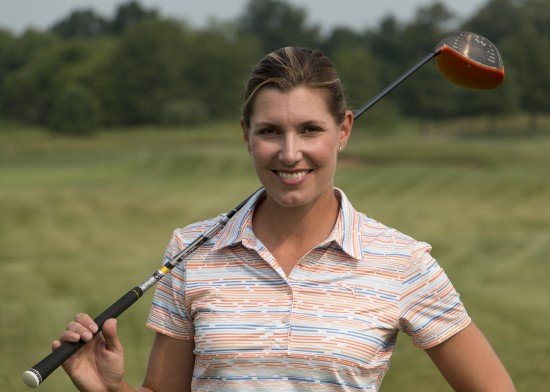
Growing up in Jackson Heights, New York, 8-year-old Erika Larkin fell in love with golf and soared, teaching herself on the small green outside Shea Stadium until PGA Professional Frank Darby started mentoring her at the age of 15, leading her to achieve a golf scholarship from James Madison University.
Now, 20 years later, Larkin has won many awards for her golfing mentorship, including Middle Atlantic PGA’s Teacher of the Year 2012. Ever since 2012, she has held the title of Golf Digest’s Best Young Teachers in America: Top 40 under 40. She has also been the featured Golf Pro on Golf Digest and the Golf Channel many times, introducing her methodical approach inspired by professional golfer Ernest Jones’ novel, Swing the Clubhead, to the big screen.
As director of instruction for The Club at Creighton Farms, she helps clients perfect their golfing skills.
The three most common struggles her students face are having too much tension in their swing, poor shifting of weight leading to an incomplete follow through, and having a tendency to be too “handsy” or too “fancy” with their swings on the short green, she says.
Swing Tension
When students have too much tension in their swing, it normally indicates an underlying fear or anxiety over where they think the ball might go or where they do not want the ball to go once it’s been hit.
“Sometimes tension creates bend,” Larkin says. “I also think it happens because, sometimes, particularly guys have a tendency to muffle the ball.”
However, this lack of fluidity can be fixed very easily.
If this is an area you tend to struggle with, Larkin recommends working on your rhythm and lightening the tension in your forearm and wrist joints before you begin.
“Feeling a good waggle is a good way of releasing some of the tension before you begin and really letting the arms and wrists act more like a whip than something where you are trying to steer the ball or help it through the swing,” Larkin says. “When people can feel the swinging motion where they swing back and forth and back and forth in a continuous way—really let the wrists and arms feel a little bit floppy—they get the sense that they can start to relax and still hit the ball from that position.”
Get a Better Follow-Through
Another common snag her students face on the golf course is poor weight shift that leads to an incomplete follow-through. This is because the golfer may hang back their weight as they swing the golf club, or they follow through, but their body is not in sync with their motion and they rotate their body at the wrong time.
Hanging back on your weight will result in rotating too early and will cause you to spin out. If you shift your weight but do not rotate at the same time, it will result in an incomplete follow-through position.
“For either of these scenarios … where their body is out of position, it impacts the arm swing, impacts directional control and also really messes up where the bottom of the swing is happening, so the pivot pattern is all over the place,” says Larkin. This is because when you hang back, your pivot is behind the ball, creating a skewed shot by hitting up on the ball.
“There are a lot of misses that can happen when your body is not in the right place at the right time,” says Larkin. However, the pro has some exercises that are surefire ways of adjusting this common golfing problem.
Larkin recommends doing slow rehearsal shots while simultaneously focusing on the downswing. The goal is to make sure that as you are executing the first move of your downswing, there is a lateral shift in the front leg before you pivot.
A great drill to practice this would be:
Step 1: Place your feet together
Step 2: Swing back
Step 3: Step out to the front side toward the target laterally
Step 4: Turn everything through
Step 5: At the end of the swing, come to a complete finish with your back foot’s toe down in the ground and your back hip around the target
Don’t Get Fancy
On the short green, simplicity is the most effective way to get the ball into the hole.
Over the years, Larkin has noticed that a lot of her students tend to try to do too much with their swings: “They try to lift the ball and scoop it and try to help it up and prop it up around the green when really the club just does the work,” Larkin says.
One way to fix this problem is to familiarize yourself, especially if you are a beginner, with the different types of golf clubs and what they can do in order to make the proper club selection based on the situation.
However, for those who want to perfect “handsy-ness” around the green, especially in the case of chipping, according to Larkin, the best way to do this is to perform a special type of practice swing where you:
Step 1: Choke down halfway on the grip.
Step 2: Let the grip end of the club rest close to the front left side of your torso.
Step 3: Make little swings that focus on the motion coming from your arms and shoulders rather than from your wrists.
Try a couple of practice shots where you focus on your arms and shoulders in relation to how you are working the club back and through instead of focusing on your wrist in order to prevent being a “wristy” player.
“If you choke down on the feel part of the shaft about halfway down and you are whacking yourself at the side of your body with the grip and you try to come through right away, you will realize that you are using too much hands in your swing,” says Larkin.
Larkin provides golf clinics, coaching plans and evaluations plus individual and small-group lessons for both members and nonmembers of The Club at Creighton Farms. She is certified by the Titleist Performance Institute and will give special personalized instruction to each one student in order to help them become the best golfers they can be.





